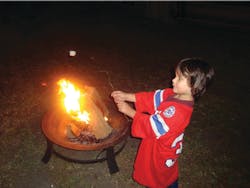A debate buzzing around the fire prevention community concerns the use of live fire during fire safety training for children. There are two camps: one that argues live fire can be used effectively and those who argue it is inappropriate. While the arguments rage back and forth, what is important is that we are having this discussion.
I have long contended we in the fire service must rethink — in fact, completely overhaul — our approach to fire safety education and training. The sharp decline in fires and fire deaths that we experienced in the 1970s has leveled off and in fact has started to increase in some categories. I theorize that one cause may be an evolution in the ways children learn and how they perceive, evaluate and prioritize risks and threats — but the fire service has not adjusted its prevention programs accordingly to these changes. Instead, we continue to approach fire safety the same way we did three decades ago.
For the record, I do not support the use of live fire in the education of children; however, I do support this debate 100%. As Worcester, MA, Deputy Fire Chief John Sullivan taught me during a Firehouse Expo presentation about lessons learned from the cold-storage warehouse fire in which six of his firefighters died: "That which goes unchallenged goes unchanged." I believe we must be open minded enough to try and find ways to improve.
I have been in the fire service for more than 14 years. I have worked in fire prevention for much of that time and I have attended a great deal of training in prevention theory and practice; however, my degree is in fire science, not education or psychology, so I am the first to say that I am no expert in this area and do not pretend to be. I only know what national statistics and experts in the field are reporting and what I see in my own community that supports those findings. Whether good or bad, you can't deny statistics supported by solid numbers.
So let's look at those numbers and statistics.
With the decrease of a solid middle class, an increased need for double-income families and an increase in single-parent homes, the "latchkey" child is more prevalent than ever. Frances Alston of the New York City Child Study Center cites a U.S. Census report in an article on education.com indicating that one third of all U.S. children between the ages of 5 and 13 are home alone at some time during the week — 15% are home alone before school, 76% after school and 9% in the evenings. Increasing numbers of children being left home alone is an obvious concern for the fire service.
Now consider National Fire Protection Association (NFPA) statistics indicating that cooking-fire injuries start to increase at age 10 and that child-set fires increase on weekends and during summer, peaking between 3 and 8 P.M. Could the numbers provided by the U.S. Census support the NFPA statistics and indicate that latchkey children are cooking for themselves and possible siblings after school, on weekends and in the summer?
According to the U.S. Fire Administration (USFA), curiosity about fire starts at age 3 and 84% of unintentional fires are started by children under 10. Further, 54% of all arson fires are committed by juveniles under 18. According to the San Diego, CA-based Burn Institute, 34% of child fire victims set the fire themselves, 40% of residential fire deaths are a result of child fire play and, nationally, fire play is the leading cause of death in the home. Obviously, children and fire continue to be a problem and while what we are doing today may be effective in some areas, we still have a great deal of room to improve and should be trying to find ways to do so.
One valid argument against the use of live fire in educating children is that it encourages the impression that fire can be controlled and is "fun." But are we being naïve? The findings outlined by the NFPA, USFA and Burn Institute indicate that fire is already in the lives of children — from the way fire is portrayed in movies and on TV shows to scout camp fires with marshmallows and hotdogs, fire is a constant in the lives of children and in a manner synonymous with fun, safety and controllability. So are we really to believe that the use of live fire by fire professionals in a prevention demonstration would lead to even more children playing with fire? Couldn't we — as recognized experts in the field of fire and with our knowledge of ignition temperatures, BTUs, flashover, toxic gases, conduction, radiation, convection, etc. — reintroduce fire to children in a manner counter to what they already see and teach them the truth about fire in a positive and constructive way?
Another argument against the use of live fire is that children should just be told to run away from fire and that to teach them to take any action would put them in more danger. It is a fact that children today are much more technology driven than they were in the 1970s. They play video games like Wii in which a computer senses body movements and translates them into motions of characters on the screen. They can master a multi-button controller using numerous action codes while never taking their eyes off the video screen. So are we really to assume that they cannot master the cognitive skills needed to operate a fire extinguisher? To comprehend the motor skills we as firefighters need to survive a fire? Are we underestimating their ability to learn and overestimating the effects fire can have in that learning process?
The fact remains that the decline in fires we once enjoyed has largely stopped. Fire use and fire play by children are serious problems and with more latchkey children being left at home and placed at risk, we can safely forecast these problems can only worsen. Add to this the belief among children that they are invincible and it is apparent that we simply must change our approach to fire prevention when the statistics clearly point to unaddressed problems.
Again, and I cannot stress this enough, I am not advocating the use of live fire in the education of children at this time. I believe that should it ever be used, just as when using puppets and clowns, it should be used by people who are trained to do so to ensure that it is being done correctly to maximize its educational value and not just be entertainment. But I do support the exploration and the further study of this issue. Facts and statistics clearly show that what we are doing now is not succeeding.
Does the idea of using live fire in the education of children sound crazy to some of you? I am sure it does. But at one time so did gasoline-powered fire apparatus, self-contained breathing apparatus (SCBA) and bunker pants, to name a few. Many lives — both civilian and firefighter — would have been lost had these "crazy ideas" not been explored and researched. So maybe for prevention, it's time to start "fighting fire with fire."
DANIEL BYRNE is a firefighter/paramedic and the community support officer for the Burton, SC, Fire District and a paramedic for Beaufort County EMS. He is a National Fire Academy alumnus and has been conducting fire service public relations programs for over 15 years. Byrne holds associate of science and bachelor of science degrees in fire science and is a Fire Instructor II. He has received state and local awards for educational programs and partnerships. Byrne is a former U.S. Marine Corps recruiter now serving with the Georgia Air National Guard Fire Protection Division. He may be contacted at [email protected].
About the Author

Daniel Byrne
DANIEL BYRNE is a community support officer for the Burton Fire District, Beaufort County, SC, and a retired assistant fire chief of training for the Georgia Air National Guard 165th Fire Department. A third-generation firefighter, he holds an associate degree and a bachelor’s degree in fire science as well as a master’s degree in public administration and disaster management. Byrne is an alumnus of the National Fire Academy. He received state and local awards for public relations and educational programs as well as community partnerships and served as a conference presenter and keynote speaker.
